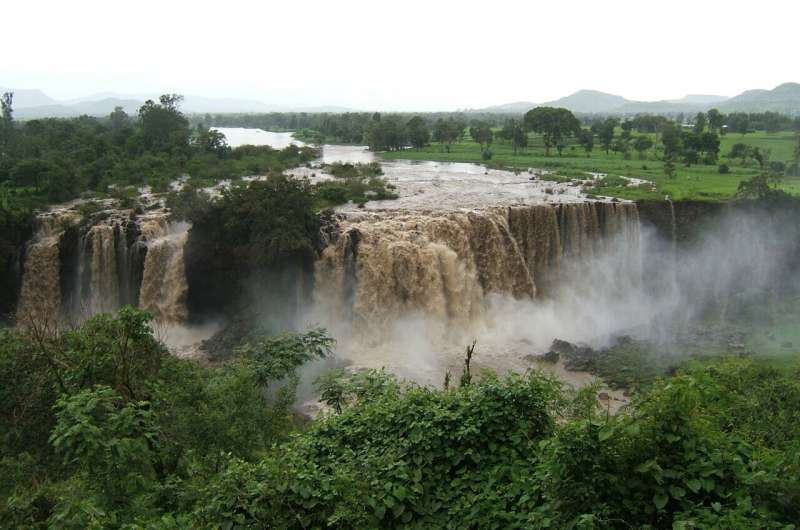This article has been reviewed according to Science X's editorial process and policies. Editors have highlighted the following attributes while ensuring the content's credibility:
fact-checked
peer-reviewed publication
trusted source
proofread
Study reveals ancient Nile floods were highly variable during wetter climates

Global warming as well as recent droughts and floods threaten large populations along the Nile Valley. Understanding how such a large river will respond to an invigorated hydrological cycle is therefore a pressing issue. Insights can be gained by studying past periods with wetter and warmer conditions, such as the North African Humid Period 11 to 6 thousand years ago.
A research team of the German Research Centre for Geosciences GFZ, led by Cécile Blanchet, together with colleagues at the University of Innsbruck (Austria) and the Alfred Wegener Institute, Helmholtz Centre for Polar and Marine Research (Germany) analyzed a 1,500 year long annually-laminated sediment core. The study was published today in Nature Geoscience.
It reveals that wetter climates led to very strong and weak floods and a highly instable river system, which may have rendered the Nile valley uninhabitable. Although intensified, flood variability was paced by similar climatic forcing as today, operating on annual—like El Niño—to multi-decadal timescales. This suggests that the occurrence of such extreme events might be predictable helping to reduce risks for local populations.
Nile River floods and climate change
The iconic floods of the Nile River are often associated with the development of irrigation and agriculture in pharaonic Egypt. Today, seasonal rainfall and flooding remain crucial to sustaining large populations in the Nile Valley, from the Equator to the Mediterranean coast.
Climate models predict a large increase in monsoonal rainfall in this region due to global warming for all climatic scenarios. Recent episodes of droughts and flooding in Ethiopia, Sudan and Egypt have raised concerns about an increase in rainfall variability leading to such geohazards. Being one of the most densely populated areas on Earth, it is critical to design reliable forecasting tools and plan adequate infrastructure based on informed knowledge and process understanding of rainfall and flood changes.
To tackle these issues, it is important to understand how large river systems will respond to enhanced rainfall. Insights can be gained from studying past time intervals that were known to be wetter and warmer than the present. A well-known example is the North African Humid Period during the Early Holocene, about 11 to 6 thousand years ago, characterized by a large increase in rainfall in northeastern Africa.
Unique sediment core provides annual inside into ancient Nile River floods
To access these ancient times, Blanchet and colleagues of the German Research Centre for Geosciences GFZ, together with Arne Ramisch (University of Innsbruck) and Monica Ionita (Alfred Wegener Institute, Helmholtz Centre for Polar and Marine Research, AWI) have analyzed a unique sediment core collected right off the Nile mouth that recorded past floods. These seasonal floods brought varying amounts of fluvial particulate matter offshore, which were preserved as fine laminations. The core was taken in 2008 and dated back to the North African Humid Period.
"Relics of such geological times provide researchers a natural laboratory to test and improve predictions from climate models," explains Blanchet. "This type of layered sediment is often found in lakes, and the GFZ is internationally known for having the technical and scientific expertise to analyze them. This one is unique because these are marine sediments recording past Nile floods at an annual resolution. So, I decided to come to the GFZ and set to explore this beautiful record."
Sediment core analysis
Analysis of the cores comprised looking at the layers, counting and measuring them under the microscope—part of which was also done at home during the COVID-lockdowns. The chronology was constrained using a combination of annual layer counting and radiocarbon dating of fossil plankton buried in the layers.

Blanchet quickly realized that the thickness of the flood layers was varying drastically in time spans of 30–40 years, from being very small (0.3 mm) to being very thick (10 mm).
"It may sound not so much, but several millimeters deposited offshore is enormous," says Blanchet. "However, we know that large rivers are complicated systems, which may retain or release sediments independently of the discharge, that is the amount of water in the river.
"So, it is not always possible to relate the volume of sediments transported, expressed in our record as the thickness of the layers, to the size of the flood. But we noticed as well that the size of the particles increased in thicker layers, which means that the thickness of the layers is a reliable indicator of the strength of past floods."
From her observations, Blanchet concluded that the North African Humid Period was characterized by the occurrence of extremely strong and variable Nile floods. Especially between 9,200 and 8,600 years ago, the dominance of thick flood layers depicts a period of strong erosional activity and the deposition of large amounts of particulate matter offshore, about two to three times as much as in the later years.
Influence of the El Niño climate oscillation
Joining forces with statisticians and modelers at the GFZ and the AWI allowed the team not only to determine the effects but also the drivers of flood variability. Using modeling of past sea-level changes done at GFZ, the researchers could exclude that any of these effects was driven by sea-level changes rather than the fluvial activity of the Nile.
Analyzing the data with statistical methods revealed several characteristic oscillations: on a shorter timescale with periodicities of 2–7 years, and on a longer time scale of several decades. This suggests that the floods were modulated by the El Niño Southern Oscillation (ENSO) on multi-annual timescales and a yet unidentified driver on multi-decadal timescales.
"ENSO originates in the Pacific region and is transmitted to other parts of the World by atmospheric teleconnections," said co-author Ionita from the AWI. "It was fascinating to see that we could find this variability both in the model and in the data."
Comparison with Nilometer flood data from the past 2000 years
The researchers compared their flood-record data from the time between 9,470 and 7,940 years before present, with data from the ancient Egyptians, recorded between 622 and 1922 CE, especially with regard to the oscillations.
"The fact that ancient Egyptians measured the level of the Nile River in special buildings called 'Nilometers'—see picture 2—year after year is really fascinating and they have offered us a unique record of past Nile floods in the last 2,000 years," said co-author Ramisch, previously at GFZ and now at the University of Innsbruck.
"The resolution and length of both records being similar, we could apply similar statistical tools and derive the main temporal variabilities. It showed us that the drivers remain quite similar even though the climatic conditions were different."
This comparison shows that similar climate drivers can have very different effects, namely a much higher amplitude of flood magnitude under wetter and warmer climates. This is one of the main findings of the study. And it has important implications for building reliable tools to forecast and reduce flood risks.
"I am sure that our findings will have direct applications and we are already working on providing constraints on flood magnitude based on the record we have. This is not trivial, but with the help of modelers and geomorphologists, I am confident that we will tackle this new challenge," concludes Blanchet.
More information: Cécile L. Blanchet et al, Climatic pacing of extreme Nile floods during the North African Humid Period, Nature Geoscience (2024). DOI: 10.1038/s41561-024-01471-9
Journal information: Nature Geoscience
Provided by Helmholtz Association of German Research Centres



















